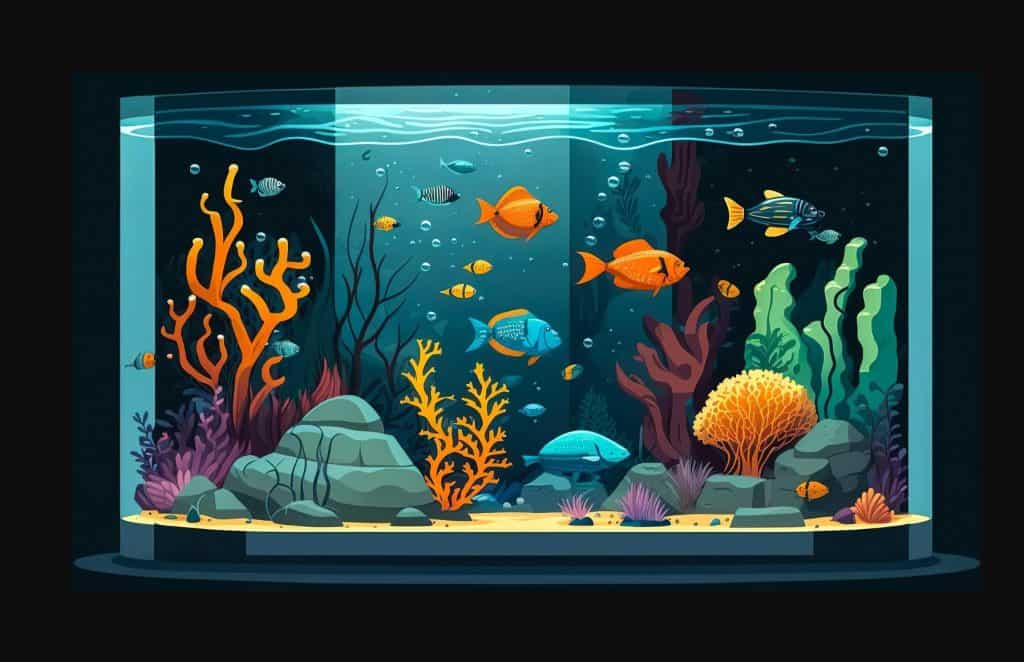Can Fish Tanks Be In Direct Sunlight

Both aquatic plants and tropical fish need light in their Aquarium for a given amount of time during the day. Using sunlight as a light source rather than aquarium light can be relatively tricky.
You will read from many trusted sources that direct sunlight is never recommended for a fish tank, though indirect sunlight is acceptable.
So, “Can Fish Tanks be in Direct Sunlight”, is not ideal, but let’s look a bit further into why and how you can use sunlight as a light source.
Why You Need Light in a Fish Tank
Firstly, any type of aquarium whether planted, not planted, freshwater or marine needs some form of light.
- Day and Night Cycle – Both fish and plants need a clear day and night cycle with between 10 to 12 hours of either dimmed or bright light per day, depending on the species.
- Energy and Oxygen – Light provides energy and oxygen for your fish, and supports Photosynthesis in plants which allows them to grow, and in turn, provides oxygen for your fish.
- Improves Immunity – Many fish species can become stressed and ill when they do not have light. Being in darkness day and night can cause their immune systems to weaken especially if they are not a species that are used to more shade in their natural habitat.
- Aesthetic Purpose – An aquarium light in the right color and intensity can showcase the beauty and colors of the plants and fish in your aquarium, to make it appear more spectacular.
In many cases, most fish species and plant species must have either artificial or indirect sunlight. However, the type of light and amount of light will largely depend on the fish species that you keep and their general aquarium setup. Some fish do prefer low light, though hardly any fish species can survive with no light.
I highly recommend doing thorough research on a fish species that you intend on keeping, taking into account their natural habitat, before you choose lighting options.
Types of Lighting Used in Aquariums
So before we get into the pros and cons of sunlight as an aquarium light, let me first explain the different types of aquarium lights that are available;
- LED Lights – LED lights are usually the best choice for most aquariums, though I must warn they can be costly, and will usually not come standard with an aquarium kit. LED lights are suitable for planted or non-planted aquariums that require Low to Medium LED Lights have many benefits which include;
- A Lower Heat Output.
- Longer Lasting
- Adjustable Light Intensity
- More Color Options
- A wider range of coverage because they are usually in strips.
- Fluorescent Lights – Two types of Fluorescent lights provide good light intensity, and generate little heat. They are;
- Standard or Normal Output Fluorescent Lights – Versatile Light fixtures for freshwater and marine water aquariums in a bulb form that are customizable, generate low heat, and offer higher light intensity.
- Compact Fluorescent Lights – They are much smaller in size, and are usually built into the hood of your aquarium to keep the right heat and humidity in the tank. Compact Fluorescents have a higher light output with low heat emission and a k=lower operating cost.
- Metal Halide Lights – Metal Halide lights are a full spectrum light source that easily replicates natural tropical lighting to sustain photosynthesis for aquarium plants. Though Metal Halide Lights will generate quite a bit of heat.
- Sunlight – Sunlight is a more natural and cost-effective way to produce light for your aquarium. Though sunlight will cause heat, especially direct sunlight, and may enhance the growth of algae. It is advisable to rather use indirect sunlight as a source of light, rather than direct sunlight.
The Pros and Cons of Using Sunlight as an Aquarium Light
Using direct sunlight as a source of light, and even some heat in your aquarium will largely depend on the type of fish and plants that you have. It basically boils down to two answers
- Tropical fish species and plants that have a natural warm habitat with direct sunlight, can be placed in direct sunlight.
- Fish such as Guppies, and plants that are used to a more shaded natural environment, and cooler water conditions should never be placed in direct sunlight.
In the first case the rule is to only place your aquarium in direct sunlight for a few hours a day, and NEVER all day. You can choose a bright sunny spot in your home that receives sunlight for a few hours, or place them near a window where you can draw the curtain.
Then again there is the case of the dreaded ALGAE!!! Now there is much controversy around this subject, as many people believe it is sunlight and even artificial light that causes the growth of algae, however, this is not essentially the case.
Three main causes of Algae are;
- Too Much Waste – Especially in a new tank, fish waste, leftover food, and even fertilizers used for plants can quickly lead to the build-up of algae.
- Few Live Plants – In a tank with mainly synthetic plants and décor, or very few plants, you are at risk of growing algae. Plants tend to outcompete algae when there are more live plants, as they consume environmental nutrients and waste that cause algae, as well as produce more oxygen.
- Overheating – Prolonged sun exposure, along with the higher room temperatures of the room where your aquarium is can cause algae.
With that said, let us look into some of the Pros and Cons of Direct Sunlight for your tank;
Benefits of Sunlight
- As we have mentioned certain fish and plant species can benefit from direct sunlight;
- Direct sunlight generally promotes the growth of plants. Plants in turn provide oxygen and help to keep tank water clean.
- Direct Sunlight is ideal for fish species who enjoy warmer water, as it can help to heat your tank water.
- Direct sunlight can provide a lighting option that will not consume energy or have any initial costs.
Precautions with Sunlight
- In intense direct sunlight, your fish can get sunburned, especially if they do not have proper shelter from plants and décor.
- Tank water can quickly overheat in direct sunlight which can be particularly dangerous for fish used to cooler water conditions.
- Prolonged sunlight along with a heated room can increase the risk of algae growth.
- Direct sunlight may stress out fish and lead to health issues such as infections and disease, if not properly monitored.
The Cons may seem to outweigh the Pros, though there is always a way around things, so if you choose Direct Sunlight, here are a few tips to prevent any issues;
How to Manage Direct Sunlight in Your Tank
If you want to or have no choice but to keep your aquarium in direct sunlight, here are a few tips to minimize common problems with direct sunlight;
- Use a Built-In sunshade for your tank.
- A UV-resistant film can be placed over the tank to filter harmful UV rays.
- You can place a larger Pot plant next to the tank to provide some shade.
- Use Floating aquatic plants for some shade.
- Heavily Plant your tank and ensure that there are enough hiding spots such as caves and rocks for your fish.
Use a water chiller in your tank to prevent overheating.
Final Thoughts
By following our tips and recommendations you can essentially keep your fish tank n direct sunlight inside your home. Though not recommended, if needed it can be done with the right knowledge and precautions. To conclude you need to remember two things;
- Only some fish species and plant species will thrive in direct sunlight, so do your research thoroughly.
- Never leave your fish tank in direct sunlight for more than a few hours, and ensure that there is ample shade and hiding space for fish.
Frequently Asked Questions
Can You Place a Fish Tank Near a Window?
By following our guidelines you can easily keep your fish tank next to a window for a few hours of sunlight. I would however recommend a UV filter if the light is very intense.
Do Fish and Plants Need Natural Sunlight?
Fish and Plants whether natural or artificial all need some form, or intensity of sunlight to grow and keep their immune systems healthy. Similarly, they need around 10 to 12 hours of light a day to mimic the natural cycle of day and night.
Do Fish Need Darkness?
To thrive fish need a clear day and night cycle. While some species are nocturnal, most require a clear indication of day and night, as they tend to sleep at night.
Can I Use Both Artificial Light and Sunlight Options?
I would not recommend direct sunlight, with artificial light, it will cause severe overheating and is unnecessary. Though some indirect sunlight should not interfere with dim to medium artificial light.
References:
- https://en.wikipedia.org/wiki/Aquarium_lighting
- https://thejbis.org/index.php/jbis/article/view/12






